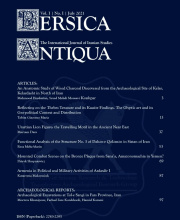۱.
کلیدواژهها:
ram-headed bronze statuette Egyptian deities Persian period Persepolis
It has been nearly 86 years since the Egyptian bronze ram-headed statuette, known as Harsaphes, was found outside the Treasury in the Garrison Street of Persepolis during the archaeological excavations by the Oriental Institute of the University of Chicago. The iconographic features of this little-known statuette is associated it with an Egyptian deity, which makes its genre unique in the heartland of the Persian Empire. It should be noted that the four ram-headed deities: Heryshef, Khnum, Amun, and Banebdjedet, sometimes bear a striking resemblance in the formal Egyptian art. This paper re-opens the discussion on the statuette’s identity, and offers a detailed comparison between this statuette and other Egyptian ram-headed deities. The results from a comparative analysis are critical to the supposed attribution of Harsaphes to the statuette, and examine the likelihood of being all four ram-headed gods.
۲.
کلیدواژهها:
The Masoretic Version of the Book of Esther The Persian Empire the Bible Achaemenian
Most modern scholars consider the Book of Esther to be a kind of historical novel; hence, the historicity of many of its characters and events is highly debatable. While the present study does not intend to defend the historicity of the book, it does review it again by using sources that have received less attention in this regard. That the Book of Esther has a lot of Persian realia in it is not news, but most scholars have debated its historical value by comparing the book with classical sources. However, the present article aims to show how a significant part of the historical material of the Book of Esther is in line with evidence that if not all, but most of the classical sources are unaware of, and accepting this fact means that the author of the Masoretic Esther had direct or indirect access to sources associated with the Persian state. In order to prove this issue, using the descriptive-analytical method based on library studies, the primary focus of this article has been on sources other than the Greek ones, mainly Achaemenian royal inscriptions, and economic and legal documents found in different parts of the Persian Empire.
۳.
کلیدواژهها:
Good Shepherd Christian Seal Motif Sasanian
The artistic background of the Good Shepherd motif can be traced to ancient eras of the East and the West. This motif later gained prominence in early Christian art. The ram-bearer (carrying a sacrificial or an offering animal) first appeared in Near Eastern art and later became an important motif in Greco-Roman art to represent certain roles of the god Hermes. This motif was considered by Christian converts as a symbol of Jesus Christ, as they represented him in the figure of a young shepherd caring for his flock. This theme can also be seen on some Sasanian seals, which can be considered as the Good Shepherd motif. In this article, the authors introduce the aforementioned motif depicted on these seals and examine their possible connection with the Christian communities. The motif of the Good Shepherd, as seen on the seals, demonstrates modifications in the original iconography. These changes can be observed in the longer dress of the ram-bearer or the engraving of celestial symbols. These modifications are probably a sign of the localization process of an imported motif in the Sasanian Empire.
۴.
کلیدواژهها:
Judeo-Persian middle Persian Early New Persian Dandān-Uiliq
This paper deals with an old Judeo-Persian letter called Dandān-Uiliq II (Abbreviated as DU II); which probably dates back to 9th century CE and further to its contents, has some important linguistic features, often without existence in later Persian texts written in Arabic script, for instance, the use of the adverb bē = but (as in Qur’an-e Qods translation), use of the conjunction kū, the use of the verb h- (to be) and ancient subjunctive mood. This paper also presents a new translation of the letter and its ancient linguistic features discussed in comparison to Early Persian texts (in Perso-Arabic script) and some early Persian translations of Qur’an, especially Qur’an-e Quds (probably written in Sistan in 12th CE). These features represent language transmission from Middle Persian to Neo-Persian (Dari). The given translation is not the same as previous English and Chinese versions and reflects my understanding of its syntax and morphology.
۱.
Achaemenid Religion, Reza MehrAfarin, Tehran, Aryaramna Press & Tissaphernes Archaeological Research Group, 2022, ISBN: 978-622-9253-12-0, 662 pp.
۲.
Middle Persian Private Inscriptions in the Sasanian and Post-Sasanian Period: Funerary and Memorial Inscriptions, Cyrus Nasrollahzadeh, Tehran, Institute for Humanities and Cultural Studies, 2019, 2 vol. (vol. 1: Text. vol. 2: Picture), 340 + 272 pp, ISBN: 978-964-426-998-1; Vol 1: 978-964-426-996-7; Vol 2: 978-964-426-997-4.
